# Objective
- In the large majority of cases, users were calling `.unwrap()` immediately after `.get_resource`.
- Attempting to add more helpful error messages here resulted in endless manual boilerplate (see #3899 and the linked PRs).
## Solution
- Add an infallible variant named `.resource` and so on.
- Use these infallible variants over `.get_resource().unwrap()` across the code base.
## Notes
I did not provide equivalent methods on `WorldCell`, in favor of removing it entirely in #3939.
## Migration Guide
Infallible variants of `.get_resource` have been added that implicitly panic, rather than needing to be unwrapped.
Replace `world.get_resource::<Foo>().unwrap()` with `world.resource::<Foo>()`.
## Impact
- `.unwrap` search results before: 1084
- `.unwrap` search results after: 942
- internal `unwrap_or_else` calls added: 4
- trivial unwrap calls removed from tests and code: 146
- uses of the new `try_get_resource` API: 11
- percentage of the time the unwrapping API was used internally: 93%
What is says on the tin.
This has got more to do with making `clippy` slightly more *quiet* than it does with changing anything that might greatly impact readability or performance.
that said, deriving `Default` for a couple of structs is a nice easy win
# Objective
- Fixes#3562
## Solution
- The outdated reference to `TextGlyphs` has been removed, and replaced with a more accurate docstring.
## What was `TextGlyphs`?
This is the real question of this Issue and PR. This is particulary interesting because not only is `TextGlyphs` not a type in bevy, but it _never was_. Indeed, this type never existed on main. Where did it come from?
`TextGlyphs` was originally a tuple struct wrapping a `Vec<PositionedGlyph>`. It was first introduced back in commit ec390aec4e in #765. At the time, position information was being stored on the text entities directly. However, after design review, [it was decided](https://github.com/bevyengine/bevy/pull/765#issuecomment-725047186) to instead store the glyphs in a `HashMap` owned by the `TextPipeline`. When this was done, the original type was not only removed, but abstracted behind a few layers of the `TextPipeline` API. Obviously, the original docstring wasn't updated accordingly.
Later, as part of #1122, the incorrect docstring was swept up when copy/pasting `text_system` for `text2d`. (Although I don't blame @CleanCut for this; it took me like 3 hours to track all this down to find the original context.)
# Objective
In this PR I added the ability to opt-out graphical backends. Closes#3155.
## Solution
I turned backends into `Option` ~~and removed panicking sub app API to force users handle the error (was suggested by `@cart`)~~.
# Objective
The current 2d rendering is specialized to render sprites, we need a generic way to render 2d items, using meshes and materials like we have for 3d.
## Solution
I cloned a good part of `bevy_pbr` into `bevy_sprite/src/mesh2d`, removed lighting and pbr itself, adapted it to 2d rendering, added a `ColorMaterial`, and modified the sprite rendering to break batches around 2d meshes.
~~The PR is a bit crude; I tried to change as little as I could in both the parts copied from 3d and the current sprite rendering to make reviewing easier. In the future, I expect we could make the sprite rendering a normal 2d material, cleanly integrated with the rest.~~ _edit: see <https://github.com/bevyengine/bevy/pull/3460#issuecomment-1003605194>_
## Remaining work
- ~~don't require mesh normals~~ _out of scope_
- ~~add an example~~ _done_
- support 2d meshes & materials in the UI?
- bikeshed names (I didn't think hard about naming, please check if it's fine)
## Remaining questions
- ~~should we add a depth buffer to 2d now that there are 2d meshes?~~ _let's revisit that when we have an opaque render phase_
- ~~should we add MSAA support to the sprites, or remove it from the 2d meshes?~~ _I added MSAA to sprites since it's really needed for 2d meshes_
- ~~how to customize vertex attributes?~~ _#3120_
Co-authored-by: Carter Anderson <mcanders1@gmail.com>
#3457 adds the `doc_markdown` clippy lint, which checks doc comments to make sure code identifiers are escaped with backticks. This causes a lot of lint errors, so this is one of a number of PR's that will fix those lint errors one crate at a time.
This PR fixes lints in the `bevy_text` crate.
Dynamic types (`DynamicStruct`, `DynamicTupleStruct`, `DynamicTuple`, `DynamicList` and `DynamicMap`) are used when deserializing scenes, but currently they can only be applied to existing concrete types. This leads to issues when trying to spawn non trivial deserialized scene.
For components, the issue is avoided by requiring that reflected components implement ~~`FromResources`~~ `FromWorld` (or `Default`). When spawning, a new concrete type is created that way, and the dynamic type is applied to it. Unfortunately, some components don't have any valid implementation of these traits.
In addition, any `Vec` or `HashMap` inside a component will panic when a dynamic type is pushed into it (for instance, `Text` panics when adding a text section).
To solve this issue, this PR adds the `FromReflect` trait that creates a concrete type from a dynamic type that represent it, derives the trait alongside the `Reflect` trait, drops the ~~`FromResources`~~ `FromWorld` requirement on reflected components, ~~and enables reflection for UI and Text bundles~~. It also adds the requirement that fields ignored with `#[reflect(ignore)]` implement `Default`, since we need to initialize them somehow.
Co-authored-by: Carter Anderson <mcanders1@gmail.com>
# Objective
- While reading code, found some queries that are `mut` and not used as such
## Solution
- Remove `mut` when possible
Co-authored-by: François <8672791+mockersf@users.noreply.github.com>
This makes the [New Bevy Renderer](#2535) the default (and only) renderer. The new renderer isn't _quite_ ready for the final release yet, but I want as many people as possible to start testing it so we can identify bugs and address feedback prior to release.
The examples are all ported over and operational with a few exceptions:
* I removed a good portion of the examples in the `shader` folder. We still have some work to do in order to make these examples possible / ergonomic / worthwhile: #3120 and "high level shader material plugins" are the big ones. This is a temporary measure.
* Temporarily removed the multiple_windows example: doing this properly in the new renderer will require the upcoming "render targets" changes. Same goes for the render_to_texture example.
* Removed z_sort_debug: entity visibility sort info is no longer available in app logic. we could do this on the "render app" side, but i dont consider it a priority.
Objective
During work on #3009 I've found that not all jobs use actions-rs, and therefore, an previous version of Rust is used for them. So while compilation and other stuff can pass, checking markup and Android build may fail with compilation errors.
Solution
This PR adds `action-rs` for any job running cargo, and updates the edition to 2021.
This implements the most minimal variant of #1843 - a derive for marker trait. This is a prerequisite to more complicated features like statically defined storage type or opt-out component reflection.
In order to make component struct's purpose explicit and avoid misuse, it must be annotated with `#[derive(Component)]` (manual impl is discouraged for compatibility). Right now this is just a marker trait, but in the future it might be expanded. Making this change early allows us to make further changes later without breaking backward compatibility for derive macro users.
This already prevents a lot of issues, like using bundles in `insert` calls. Primitive types are no longer valid components as well. This can be easily worked around by adding newtype wrappers and deriving `Component` for them.
One funny example of prevented bad code (from our own tests) is when an newtype struct or enum variant is used. Previously, it was possible to write `insert(Newtype)` instead of `insert(Newtype(value))`. That code compiled, because function pointers (in this case newtype struct constructor) implement `Send + Sync + 'static`, so we allowed them to be used as components. This is no longer the case and such invalid code will trigger a compile error.
Co-authored-by: = <=>
Co-authored-by: TheRawMeatball <therawmeatball@gmail.com>
Co-authored-by: Carter Anderson <mcanders1@gmail.com>
# Objective
Enable using exact World lifetimes during read-only access . This is motivated by the new renderer's need to allow read-only world-only queries to outlive the query itself (but still be constrained by the world lifetime).
For example:
115b170d1f/pipelined/bevy_pbr2/src/render/mod.rs (L774)
## Solution
Split out SystemParam state and world lifetimes and pipe those lifetimes up to read-only Query ops (and add into_inner for Res). According to every safety test I've run so far (except one), this is safe (see the temporary safety test commit). Note that changing the mutable variants to the new lifetimes would allow aliased mutable pointers (try doing that to see how it affects the temporary safety tests).
The new state lifetime on SystemParam does make `#[derive(SystemParam)]` more cumbersome (the current impl requires PhantomData if you don't use both lifetimes). We can make this better by detecting whether or not a lifetime is used in the derive and adjusting accordingly, but that should probably be done in its own pr.
## Why is this a draft?
The new lifetimes break QuerySet safety in one very specific case (see the query_set system in system_safety_test). We need to solve this before we can use the lifetimes given.
This is due to the fact that QuerySet is just a wrapper over Query, which now relies on world lifetimes instead of `&self` lifetimes to prevent aliasing (but in systems, each Query has its own implied lifetime, not a centralized world lifetime). I believe the fix is to rewrite QuerySet to have its own World lifetime (and own the internal reference). This will complicate the impl a bit, but I think it is doable. I'm curious if anyone else has better ideas.
Personally, I think these new lifetimes need to happen. We've gotta have a way to directly tie read-only World queries to the World lifetime. The new renderer is the first place this has come up, but I doubt it will be the last. Worst case scenario we can come up with a second `WorldLifetimeQuery<Q, F = ()>` parameter to enable these read-only scenarios, but I'd rather not add another type to the type zoo.
# Objective
- Remove all the `.system()` possible.
- Check for remaining missing cases.
## Solution
- Remove all `.system()`, fix compile errors
- 32 calls to `.system()` remains, mostly internals, the few others should be removed after #2446
This is extracted out of eb8f973646476b4a4926ba644a77e2b3a5772159 and includes some additional changes to remove all references to AppBuilder and fix examples that still used App::build() instead of App::new(). In addition I didn't extract the sub app feature as it isn't ready yet.
You can use `git diff --diff-filter=M eb8f973646476b4a4926ba644a77e2b3a5772159` to find all differences in this PR. The `--diff-filtered=M` filters all files added in the original commit but not in this commit away.
Co-Authored-By: Carter Anderson <mcanders1@gmail.com>
This relicenses Bevy under the dual MIT or Apache-2.0 license. For rationale, see #2373.
* Changes the LICENSE file to describe the dual license. Moved the MIT license to docs/LICENSE-MIT. Added the Apache-2.0 license to docs/LICENSE-APACHE. I opted for this approach over dumping both license files at the root (the more common approach) for a number of reasons:
* Github links to the "first" license file (LICENSE-APACHE) in its license links (you can see this in the wgpu and rust-analyzer repos). People clicking these links might erroneously think that the apache license is the only option. Rust and Amethyst both use COPYRIGHT or COPYING files to solve this problem, but this creates more file noise (if you do everything at the root) and the naming feels way less intuitive.
* People have a reflex to look for a LICENSE file. By providing a single license file at the root, we make it easy for them to understand our licensing approach.
* I like keeping the root clean and noise free
* There is precedent for putting the apache and mit license text in sub folders (amethyst)
* Removed the `Copyright (c) 2020 Carter Anderson` copyright notice from the MIT license. I don't care about this attribution, it might make license compliance more difficult in some cases, and it didn't properly attribute other contributors. We shoudn't replace it with something like "Copyright (c) 2021 Bevy Contributors" because "Bevy Contributors" is not a legal entity. Instead, we just won't include the copyright line (which has precedent ... Rust also uses this approach).
* Updates crates to use the new "MIT OR Apache-2.0" license value
* Removes the old legion-transform license file from bevy_transform. bevy_transform has been its own, fully custom implementation for a long time and that license no longer applies.
* Added a License section to the main readme
* Updated our Bevy Plugin licensing guidelines.
As a follow-up we should update the website to properly describe the new license.
Closes#2373
This was tested using cargo generate-lockfile -Zminimal-versions.
The following indirect dependencies also have minimal version
dependencies. For at least num, rustc-serialize and rand this is
necessary to compile on rustc versions that are not older than 1.0.
* num = "0.1.27"
* rustc-serialize = "0.3.20"
* termcolor = "1.0.4"
* libudev-sys = "0.1.1"
* rand = "0.3.14"
* ab_glyph = "0.2.7
Based on https://github.com/bevyengine/bevy/pull/2455
This PR adds two systems to the sprite module that culls Sprites and AtlasSprites that are not within the camera's view.
This is achieved by removing / adding a new `Viewable` Component dynamically.
Some of the render queries now use a `With<Viewable>` filter to only process the sprites that are actually on screen, which improves performance drastically for scene swith a large amount of sprites off-screen.
https://streamable.com/vvzh2u
This scene shows a map with a 320x320 tiles, with a grid size of 64p.
This is exactly 102400 Sprites in the entire scene.
Without this PR, this scene runs with 1 to 4 FPS.
With this PR..
.. at 720p, there are around 600 visible sprites and runs at ~215 FPS
.. at 1440p there are around 2000 visible sprites and runs at ~135 FPS
The Systems this PR adds take around 1.2ms (with 100K+ sprites in the scene)
Note:
This is only implemented for Sprites and AtlasTextureSprites.
There is no culling for 3D in this PR.
Co-authored-by: Carter Anderson <mcanders1@gmail.com>
`Color` can now be from different color spaces or representation:
- sRGB
- linear RGB
- HSL
This fixes#1193 by allowing the creation of const colors of all types, and writing it to the linear RGB color space for rendering.
I went with an enum after trying with two different types (`Color` and `LinearColor`) to be able to use the different variants in all place where a `Color` is expected.
I also added the HLS representation because:
- I like it
- it's useful for some case, see example `contributors`: I can just change the saturation and lightness while keeping the hue of the color
- I think adding another variant not using `red`, `green`, `blue` makes it clearer there are differences
Co-authored-by: Carter Anderson <mcanders1@gmail.com>
* Adds labels and orderings to systems that need them (uses the new many-to-many labels for InputSystem)
* Removes the Event, PreEvent, Scene, and Ui stages in favor of First, PreUpdate, and PostUpdate (there is more collapsing potential, such as the Asset stages and _maybe_ removing First, but those have more nuance so they should be handled separately)
* Ambiguity detection now prints component conflicts
* Removed broken change filters from flex calculation (which implicitly relied on the z-update system always modifying translation.z). This will require more work to make it behave as expected so i just removed it (and it was already doing this work every frame).
# Bevy ECS V2
This is a rewrite of Bevy ECS (basically everything but the new executor/schedule, which are already awesome). The overall goal was to improve the performance and versatility of Bevy ECS. Here is a quick bulleted list of changes before we dive into the details:
* Complete World rewrite
* Multiple component storage types:
* Tables: fast cache friendly iteration, slower add/removes (previously called Archetypes)
* Sparse Sets: fast add/remove, slower iteration
* Stateful Queries (caches query results for faster iteration. fragmented iteration is _fast_ now)
* Stateful System Params (caches expensive operations. inspired by @DJMcNab's work in #1364)
* Configurable System Params (users can set configuration when they construct their systems. once again inspired by @DJMcNab's work)
* Archetypes are now "just metadata", component storage is separate
* Archetype Graph (for faster archetype changes)
* Component Metadata
* Configure component storage type
* Retrieve information about component size/type/name/layout/send-ness/etc
* Components are uniquely identified by a densely packed ComponentId
* TypeIds are now totally optional (which should make implementing scripting easier)
* Super fast "for_each" query iterators
* Merged Resources into World. Resources are now just a special type of component
* EntityRef/EntityMut builder apis (more efficient and more ergonomic)
* Fast bitset-backed `Access<T>` replaces old hashmap-based approach everywhere
* Query conflicts are determined by component access instead of archetype component access (to avoid random failures at runtime)
* With/Without are still taken into account for conflicts, so this should still be comfy to use
* Much simpler `IntoSystem` impl
* Significantly reduced the amount of hashing throughout the ecs in favor of Sparse Sets (indexed by densely packed ArchetypeId, ComponentId, BundleId, and TableId)
* Safety Improvements
* Entity reservation uses a normal world reference instead of unsafe transmute
* QuerySets no longer transmute lifetimes
* Made traits "unsafe" where relevant
* More thorough safety docs
* WorldCell
* Exposes safe mutable access to multiple resources at a time in a World
* Replaced "catch all" `System::update_archetypes(world: &World)` with `System::new_archetype(archetype: &Archetype)`
* Simpler Bundle implementation
* Replaced slow "remove_bundle_one_by_one" used as fallback for Commands::remove_bundle with fast "remove_bundle_intersection"
* Removed `Mut<T>` query impl. it is better to only support one way: `&mut T`
* Removed with() from `Flags<T>` in favor of `Option<Flags<T>>`, which allows querying for flags to be "filtered" by default
* Components now have is_send property (currently only resources support non-send)
* More granular module organization
* New `RemovedComponents<T>` SystemParam that replaces `query.removed::<T>()`
* `world.resource_scope()` for mutable access to resources and world at the same time
* WorldQuery and QueryFilter traits unified. FilterFetch trait added to enable "short circuit" filtering. Auto impled for cases that don't need it
* Significantly slimmed down SystemState in favor of individual SystemParam state
* System Commands changed from `commands: &mut Commands` back to `mut commands: Commands` (to allow Commands to have a World reference)
Fixes#1320
## `World` Rewrite
This is a from-scratch rewrite of `World` that fills the niche that `hecs` used to. Yes, this means Bevy ECS is no longer a "fork" of hecs. We're going out our own!
(the only shared code between the projects is the entity id allocator, which is already basically ideal)
A huge shout out to @SanderMertens (author of [flecs](https://github.com/SanderMertens/flecs)) for sharing some great ideas with me (specifically hybrid ecs storage and archetype graphs). He also helped advise on a number of implementation details.
## Component Storage (The Problem)
Two ECS storage paradigms have gained a lot of traction over the years:
* **Archetypal ECS**:
* Stores components in "tables" with static schemas. Each "column" stores components of a given type. Each "row" is an entity.
* Each "archetype" has its own table. Adding/removing an entity's component changes the archetype.
* Enables super-fast Query iteration due to its cache-friendly data layout
* Comes at the cost of more expensive add/remove operations for an Entity's components, because all components need to be copied to the new archetype's "table"
* **Sparse Set ECS**:
* Stores components of the same type in densely packed arrays, which are sparsely indexed by densely packed unsigned integers (Entity ids)
* Query iteration is slower than Archetypal ECS because each entity's component could be at any position in the sparse set. This "random access" pattern isn't cache friendly. Additionally, there is an extra layer of indirection because you must first map the entity id to an index in the component array.
* Adding/removing components is a cheap, constant time operation
Bevy ECS V1, hecs, legion, flec, and Unity DOTS are all "archetypal ecs-es". I personally think "archetypal" storage is a good default for game engines. An entity's archetype doesn't need to change frequently in general, and it creates "fast by default" query iteration (which is a much more common operation). It is also "self optimizing". Users don't need to think about optimizing component layouts for iteration performance. It "just works" without any extra boilerplate.
Shipyard and EnTT are "sparse set ecs-es". They employ "packing" as a way to work around the "suboptimal by default" iteration performance for specific sets of components. This helps, but I didn't think this was a good choice for a general purpose engine like Bevy because:
1. "packs" conflict with each other. If bevy decides to internally pack the Transform and GlobalTransform components, users are then blocked if they want to pack some custom component with Transform.
2. users need to take manual action to optimize
Developers selecting an ECS framework are stuck with a hard choice. Select an "archetypal" framework with "fast iteration everywhere" but without the ability to cheaply add/remove components, or select a "sparse set" framework to cheaply add/remove components but with slower iteration performance.
## Hybrid Component Storage (The Solution)
In Bevy ECS V2, we get to have our cake and eat it too. It now has _both_ of the component storage types above (and more can be added later if needed):
* **Tables** (aka "archetypal" storage)
* The default storage. If you don't configure anything, this is what you get
* Fast iteration by default
* Slower add/remove operations
* **Sparse Sets**
* Opt-in
* Slower iteration
* Faster add/remove operations
These storage types complement each other perfectly. By default Query iteration is fast. If developers know that they want to add/remove a component at high frequencies, they can set the storage to "sparse set":
```rust
world.register_component(
ComponentDescriptor:🆕:<MyComponent>(StorageType::SparseSet)
).unwrap();
```
## Archetypes
Archetypes are now "just metadata" ... they no longer store components directly. They do store:
* The `ComponentId`s of each of the Archetype's components (and that component's storage type)
* Archetypes are uniquely defined by their component layouts
* For example: entities with "table" components `[A, B, C]` _and_ "sparse set" components `[D, E]` will always be in the same archetype.
* The `TableId` associated with the archetype
* For now each archetype has exactly one table (which can have no components),
* There is a 1->Many relationship from Tables->Archetypes. A given table could have any number of archetype components stored in it:
* Ex: an entity with "table storage" components `[A, B, C]` and "sparse set" components `[D, E]` will share the same `[A, B, C]` table as an entity with `[A, B, C]` table component and `[F]` sparse set components.
* This 1->Many relationship is how we preserve fast "cache friendly" iteration performance when possible (more on this later)
* A list of entities that are in the archetype and the row id of the table they are in
* ArchetypeComponentIds
* unique densely packed identifiers for (ArchetypeId, ComponentId) pairs
* used by the schedule executor for cheap system access control
* "Archetype Graph Edges" (see the next section)
## The "Archetype Graph"
Archetype changes in Bevy (and a number of other archetypal ecs-es) have historically been expensive to compute. First, you need to allocate a new vector of the entity's current component ids, add or remove components based on the operation performed, sort it (to ensure it is order-independent), then hash it to find the archetype (if it exists). And thats all before we get to the _already_ expensive full copy of all components to the new table storage.
The solution is to build a "graph" of archetypes to cache these results. @SanderMertens first exposed me to the idea (and he got it from @gjroelofs, who came up with it). They propose adding directed edges between archetypes for add/remove component operations. If `ComponentId`s are densely packed, you can use sparse sets to cheaply jump between archetypes.
Bevy takes this one step further by using add/remove `Bundle` edges instead of `Component` edges. Bevy encourages the use of `Bundles` to group add/remove operations. This is largely for "clearer game logic" reasons, but it also helps cut down on the number of archetype changes required. `Bundles` now also have densely-packed `BundleId`s. This allows us to use a _single_ edge for each bundle operation (rather than needing to traverse N edges ... one for each component). Single component operations are also bundles, so this is strictly an improvement over a "component only" graph.
As a result, an operation that used to be _heavy_ (both for allocations and compute) is now two dirt-cheap array lookups and zero allocations.
## Stateful Queries
World queries are now stateful. This allows us to:
1. Cache archetype (and table) matches
* This resolves another issue with (naive) archetypal ECS: query performance getting worse as the number of archetypes goes up (and fragmentation occurs).
2. Cache Fetch and Filter state
* The expensive parts of fetch/filter operations (such as hashing the TypeId to find the ComponentId) now only happen once when the Query is first constructed
3. Incrementally build up state
* When new archetypes are added, we only process the new archetypes (no need to rebuild state for old archetypes)
As a result, the direct `World` query api now looks like this:
```rust
let mut query = world.query::<(&A, &mut B)>();
for (a, mut b) in query.iter_mut(&mut world) {
}
```
Requiring `World` to generate stateful queries (rather than letting the `QueryState` type be constructed separately) allows us to ensure that _all_ queries are properly initialized (and the relevant world state, such as ComponentIds). This enables QueryState to remove branches from its operations that check for initialization status (and also enables query.iter() to take an immutable world reference because it doesn't need to initialize anything in world).
However in systems, this is a non-breaking change. State management is done internally by the relevant SystemParam.
## Stateful SystemParams
Like Queries, `SystemParams` now also cache state. For example, `Query` system params store the "stateful query" state mentioned above. Commands store their internal `CommandQueue`. This means you can now safely use as many separate `Commands` parameters in your system as you want. `Local<T>` system params store their `T` value in their state (instead of in Resources).
SystemParam state also enabled a significant slim-down of SystemState. It is much nicer to look at now.
Per-SystemParam state naturally insulates us from an "aliased mut" class of errors we have hit in the past (ex: using multiple `Commands` system params).
(credit goes to @DJMcNab for the initial idea and draft pr here #1364)
## Configurable SystemParams
@DJMcNab also had the great idea to make SystemParams configurable. This allows users to provide some initial configuration / values for system parameters (when possible). Most SystemParams have no config (the config type is `()`), but the `Local<T>` param now supports user-provided parameters:
```rust
fn foo(value: Local<usize>) {
}
app.add_system(foo.system().config(|c| c.0 = Some(10)));
```
## Uber Fast "for_each" Query Iterators
Developers now have the choice to use a fast "for_each" iterator, which yields ~1.5-3x iteration speed improvements for "fragmented iteration", and minor ~1.2x iteration speed improvements for unfragmented iteration.
```rust
fn system(query: Query<(&A, &mut B)>) {
// you now have the option to do this for a speed boost
query.for_each_mut(|(a, mut b)| {
});
// however normal iterators are still available
for (a, mut b) in query.iter_mut() {
}
}
```
I think in most cases we should continue to encourage "normal" iterators as they are more flexible and more "rust idiomatic". But when that extra "oomf" is needed, it makes sense to use `for_each`.
We should also consider using `for_each` for internal bevy systems to give our users a nice speed boost (but that should be a separate pr).
## Component Metadata
`World` now has a `Components` collection, which is accessible via `world.components()`. This stores mappings from `ComponentId` to `ComponentInfo`, as well as `TypeId` to `ComponentId` mappings (where relevant). `ComponentInfo` stores information about the component, such as ComponentId, TypeId, memory layout, send-ness (currently limited to resources), and storage type.
## Significantly Cheaper `Access<T>`
We used to use `TypeAccess<TypeId>` to manage read/write component/archetype-component access. This was expensive because TypeIds must be hashed and compared individually. The parallel executor got around this by "condensing" type ids into bitset-backed access types. This worked, but it had to be re-generated from the `TypeAccess<TypeId>`sources every time archetypes changed.
This pr removes TypeAccess in favor of faster bitset access everywhere. We can do this thanks to the move to densely packed `ComponentId`s and `ArchetypeComponentId`s.
## Merged Resources into World
Resources had a lot of redundant functionality with Components. They stored typed data, they had access control, they had unique ids, they were queryable via SystemParams, etc. In fact the _only_ major difference between them was that they were unique (and didn't correlate to an entity).
Separate resources also had the downside of requiring a separate set of access controls, which meant the parallel executor needed to compare more bitsets per system and manage more state.
I initially got the "separate resources" idea from `legion`. I think that design was motivated by the fact that it made the direct world query/resource lifetime interactions more manageable. It certainly made our lives easier when using Resources alongside hecs/bevy_ecs. However we already have a construct for safely and ergonomically managing in-world lifetimes: systems (which use `Access<T>` internally).
This pr merges Resources into World:
```rust
world.insert_resource(1);
world.insert_resource(2.0);
let a = world.get_resource::<i32>().unwrap();
let mut b = world.get_resource_mut::<f64>().unwrap();
*b = 3.0;
```
Resources are now just a special kind of component. They have their own ComponentIds (and their own resource TypeId->ComponentId scope, so they don't conflict wit components of the same type). They are stored in a special "resource archetype", which stores components inside the archetype using a new `unique_components` sparse set (note that this sparse set could later be used to implement Tags). This allows us to keep the code size small by reusing existing datastructures (namely Column, Archetype, ComponentFlags, and ComponentInfo). This allows us the executor to use a single `Access<ArchetypeComponentId>` per system. It should also make scripting language integration easier.
_But_ this merge did create problems for people directly interacting with `World`. What if you need mutable access to multiple resources at the same time? `world.get_resource_mut()` borrows World mutably!
## WorldCell
WorldCell applies the `Access<ArchetypeComponentId>` concept to direct world access:
```rust
let world_cell = world.cell();
let a = world_cell.get_resource_mut::<i32>().unwrap();
let b = world_cell.get_resource_mut::<f64>().unwrap();
```
This adds cheap runtime checks (a sparse set lookup of `ArchetypeComponentId` and a counter) to ensure that world accesses do not conflict with each other. Each operation returns a `WorldBorrow<'w, T>` or `WorldBorrowMut<'w, T>` wrapper type, which will release the relevant ArchetypeComponentId resources when dropped.
World caches the access sparse set (and only one cell can exist at a time), so `world.cell()` is a cheap operation.
WorldCell does _not_ use atomic operations. It is non-send, does a mutable borrow of world to prevent other accesses, and uses a simple `Rc<RefCell<ArchetypeComponentAccess>>` wrapper in each WorldBorrow pointer.
The api is currently limited to resource access, but it can and should be extended to queries / entity component access.
## Resource Scopes
WorldCell does not yet support component queries, and even when it does there are sometimes legitimate reasons to want a mutable world ref _and_ a mutable resource ref (ex: bevy_render and bevy_scene both need this). In these cases we could always drop down to the unsafe `world.get_resource_unchecked_mut()`, but that is not ideal!
Instead developers can use a "resource scope"
```rust
world.resource_scope(|world: &mut World, a: &mut A| {
})
```
This temporarily removes the `A` resource from `World`, provides mutable pointers to both, and re-adds A to World when finished. Thanks to the move to ComponentIds/sparse sets, this is a cheap operation.
If multiple resources are required, scopes can be nested. We could also consider adding a "resource tuple" to the api if this pattern becomes common and the boilerplate gets nasty.
## Query Conflicts Use ComponentId Instead of ArchetypeComponentId
For safety reasons, systems cannot contain queries that conflict with each other without wrapping them in a QuerySet. On bevy `main`, we use ArchetypeComponentIds to determine conflicts. This is nice because it can take into account filters:
```rust
// these queries will never conflict due to their filters
fn filter_system(a: Query<&mut A, With<B>>, b: Query<&mut B, Without<B>>) {
}
```
But it also has a significant downside:
```rust
// these queries will not conflict _until_ an entity with A, B, and C is spawned
fn maybe_conflicts_system(a: Query<(&mut A, &C)>, b: Query<(&mut A, &B)>) {
}
```
The system above will panic at runtime if an entity with A, B, and C is spawned. This makes it hard to trust that your game logic will run without crashing.
In this pr, I switched to using `ComponentId` instead. This _is_ more constraining. `maybe_conflicts_system` will now always fail, but it will do it consistently at startup. Naively, it would also _disallow_ `filter_system`, which would be a significant downgrade in usability. Bevy has a number of internal systems that rely on disjoint queries and I expect it to be a common pattern in userspace.
To resolve this, I added a new `FilteredAccess<T>` type, which wraps `Access<T>` and adds with/without filters. If two `FilteredAccess` have with/without values that prove they are disjoint, they will no longer conflict.
## EntityRef / EntityMut
World entity operations on `main` require that the user passes in an `entity` id to each operation:
```rust
let entity = world.spawn((A, )); // create a new entity with A
world.get::<A>(entity);
world.insert(entity, (B, C));
world.insert_one(entity, D);
```
This means that each operation needs to look up the entity location / verify its validity. The initial spawn operation also requires a Bundle as input. This can be awkward when no components are required (or one component is required).
These operations have been replaced by `EntityRef` and `EntityMut`, which are "builder-style" wrappers around world that provide read and read/write operations on a single, pre-validated entity:
```rust
// spawn now takes no inputs and returns an EntityMut
let entity = world.spawn()
.insert(A) // insert a single component into the entity
.insert_bundle((B, C)) // insert a bundle of components into the entity
.id() // id returns the Entity id
// Returns EntityMut (or panics if the entity does not exist)
world.entity_mut(entity)
.insert(D)
.insert_bundle(SomeBundle::default());
{
// returns EntityRef (or panics if the entity does not exist)
let d = world.entity(entity)
.get::<D>() // gets the D component
.unwrap();
// world.get still exists for ergonomics
let d = world.get::<D>(entity).unwrap();
}
// These variants return Options if you want to check existence instead of panicing
world.get_entity_mut(entity)
.unwrap()
.insert(E);
if let Some(entity_ref) = world.get_entity(entity) {
let d = entity_ref.get::<D>().unwrap();
}
```
This _does not_ affect the current Commands api or terminology. I think that should be a separate conversation as that is a much larger breaking change.
## Safety Improvements
* Entity reservation in Commands uses a normal world borrow instead of an unsafe transmute
* QuerySets no longer transmutes lifetimes
* Made traits "unsafe" when implementing a trait incorrectly could cause unsafety
* More thorough safety docs
## RemovedComponents SystemParam
The old approach to querying removed components: `query.removed:<T>()` was confusing because it had no connection to the query itself. I replaced it with the following, which is both clearer and allows us to cache the ComponentId mapping in the SystemParamState:
```rust
fn system(removed: RemovedComponents<T>) {
for entity in removed.iter() {
}
}
```
## Simpler Bundle implementation
Bundles are no longer responsible for sorting (or deduping) TypeInfo. They are just a simple ordered list of component types / data. This makes the implementation smaller and opens the door to an easy "nested bundle" implementation in the future (which i might even add in this pr). Duplicate detection is now done once per bundle type by World the first time a bundle is used.
## Unified WorldQuery and QueryFilter types
(don't worry they are still separate type _parameters_ in Queries .. this is a non-breaking change)
WorldQuery and QueryFilter were already basically identical apis. With the addition of `FetchState` and more storage-specific fetch methods, the overlap was even clearer (and the redundancy more painful).
QueryFilters are now just `F: WorldQuery where F::Fetch: FilterFetch`. FilterFetch requires `Fetch<Item = bool>` and adds new "short circuit" variants of fetch methods. This enables a filter tuple like `(With<A>, Without<B>, Changed<C>)` to stop evaluating the filter after the first mismatch is encountered. FilterFetch is automatically implemented for `Fetch` implementations that return bool.
This forces fetch implementations that return things like `(bool, bool, bool)` (such as the filter above) to manually implement FilterFetch and decide whether or not to short-circuit.
## More Granular Modules
World no longer globs all of the internal modules together. It now exports `core`, `system`, and `schedule` separately. I'm also considering exporting `core` submodules directly as that is still pretty "glob-ey" and unorganized (feedback welcome here).
## Remaining Draft Work (to be done in this pr)
* ~~panic on conflicting WorldQuery fetches (&A, &mut A)~~
* ~~bevy `main` and hecs both currently allow this, but we should protect against it if possible~~
* ~~batch_iter / par_iter (currently stubbed out)~~
* ~~ChangedRes~~
* ~~I skipped this while we sort out #1313. This pr should be adapted to account for whatever we land on there~~.
* ~~The `Archetypes` and `Tables` collections use hashes of sorted lists of component ids to uniquely identify each archetype/table. This hash is then used as the key in a HashMap to look up the relevant ArchetypeId or TableId. (which doesn't handle hash collisions properly)~~
* ~~It is currently unsafe to generate a Query from "World A", then use it on "World B" (despite the api claiming it is safe). We should probably close this gap. This could be done by adding a randomly generated WorldId to each world, then storing that id in each Query. They could then be compared to each other on each `query.do_thing(&world)` operation. This _does_ add an extra branch to each query operation, so I'm open to other suggestions if people have them.~~
* ~~Nested Bundles (if i find time)~~
## Potential Future Work
* Expand WorldCell to support queries.
* Consider not allocating in the empty archetype on `world.spawn()`
* ex: return something like EntityMutUninit, which turns into EntityMut after an `insert` or `insert_bundle` op
* this actually regressed performance last time i tried it, but in theory it should be faster
* Optimize SparseSet::insert (see `PERF` comment on insert)
* Replace SparseArray `Option<T>` with T::MAX to cut down on branching
* would enable cheaper get_unchecked() operations
* upstream fixedbitset optimizations
* fixedbitset could be allocation free for small block counts (store blocks in a SmallVec)
* fixedbitset could have a const constructor
* Consider implementing Tags (archetype-specific by-value data that affects archetype identity)
* ex: ArchetypeA could have `[A, B, C]` table components and `[D(1)]` "tag" component. ArchetypeB could have `[A, B, C]` table components and a `[D(2)]` tag component. The archetypes are different, despite both having D tags because the value inside D is different.
* this could potentially build on top of the `archetype.unique_components` added in this pr for resource storage.
* Consider reverting `all_tuples` proc macro in favor of the old `macro_rules` implementation
* all_tuples is more flexible and produces cleaner documentation (the macro_rules version produces weird type parameter orders due to parser constraints)
* but unfortunately all_tuples also appears to make Rust Analyzer sad/slow when working inside of `bevy_ecs` (does not affect user code)
* Consider "resource queries" and/or "mixed resource and entity component queries" as an alternative to WorldCell
* this is basically just "systems" so maybe it's not worth it
* Add more world ops
* `world.clear()`
* `world.reserve<T: Bundle>(count: usize)`
* Try using the old archetype allocation strategy (allocate new memory on resize and copy everything over). I expect this to improve batch insertion performance at the cost of unbatched performance. But thats just a guess. I'm not an allocation perf pro :)
* Adapt Commands apis for consistency with new World apis
## Benchmarks
key:
* `bevy_old`: bevy `main` branch
* `bevy`: this branch
* `_foreach`: uses an optimized for_each iterator
* ` _sparse`: uses sparse set storage (if unspecified assume table storage)
* `_system`: runs inside a system (if unspecified assume test happens via direct world ops)
### Simple Insert (from ecs_bench_suite)
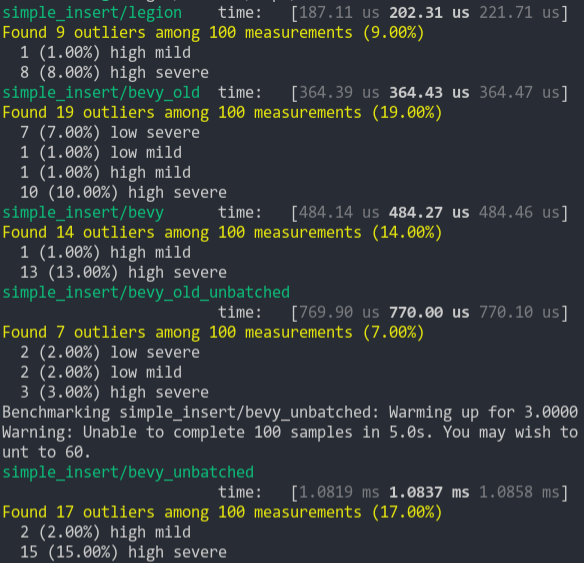
### Simpler Iter (from ecs_bench_suite)
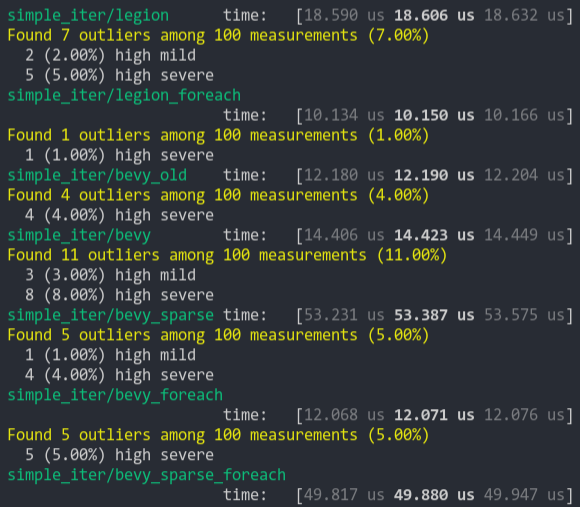
### Fragment Iter (from ecs_bench_suite)
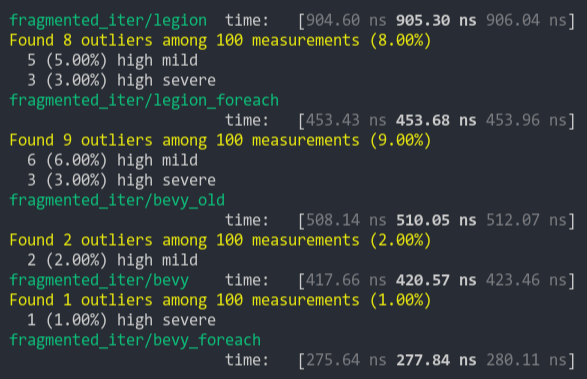
### Sparse Fragmented Iter
Iterate a query that matches 5 entities from a single matching archetype, but there are 100 unmatching archetypes
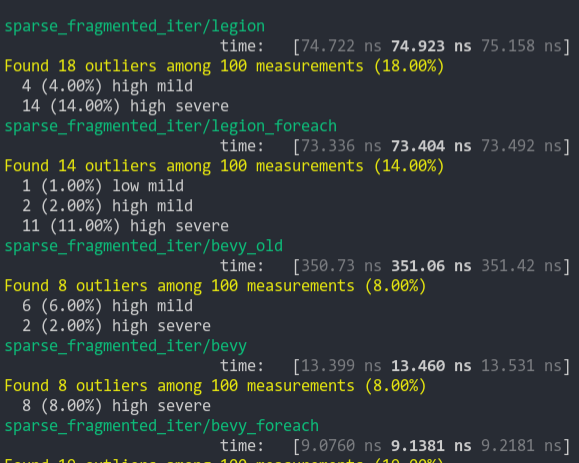
### Schedule (from ecs_bench_suite)
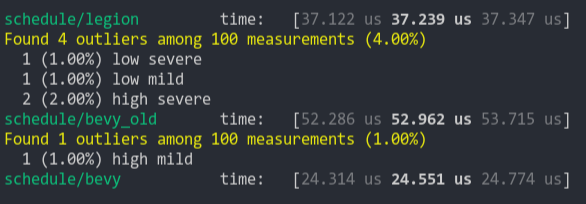
### Add Remove Component (from ecs_bench_suite)
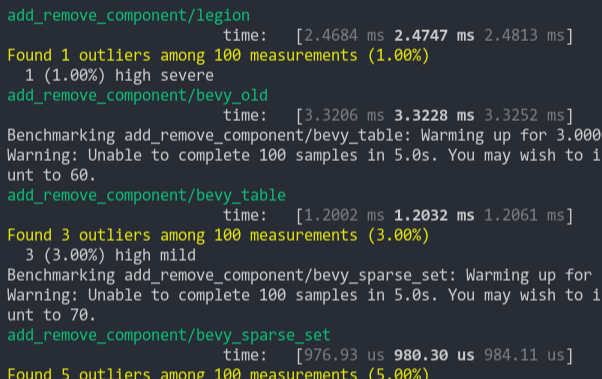
### Add Remove Component Big
Same as the test above, but each entity has 5 "large" matrix components and 1 "large" matrix component is added and removed
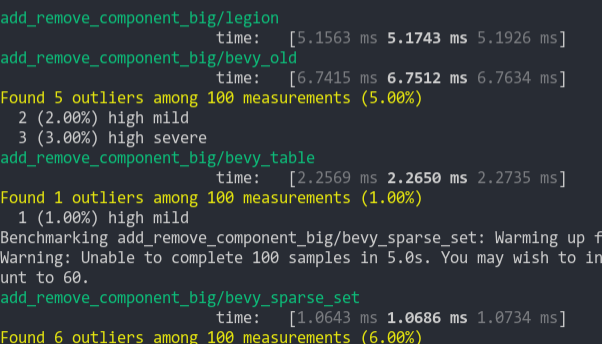
### Get Component
Looks up a single component value a large number of times
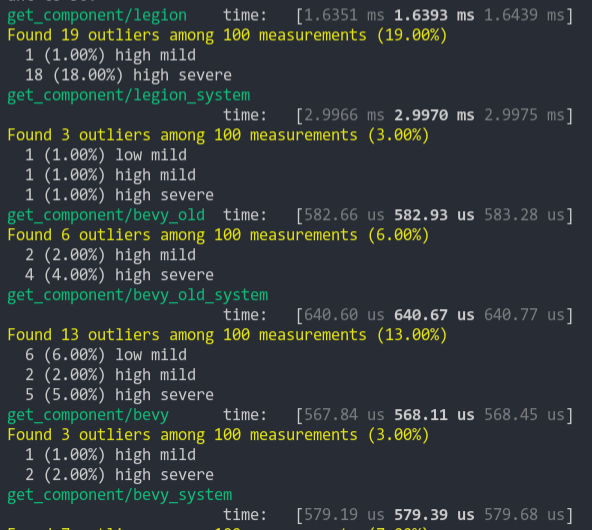
OK, here's my attempt at sprite flipping. There are a couple of points that I need review/help on, but I think the UX is about ideal:
```rust
.spawn(SpriteBundle {
material: materials.add(texture_handle.into()),
sprite: Sprite {
// Flip the sprite along the x axis
flip: SpriteFlip { x: true, y: false },
..Default::default()
},
..Default::default()
});
```
Now for the issues. The big issue is that for some reason, when flipping the UVs on the sprite, there is a light "bleeding" or whatever you call it where the UV tries to sample past the texture boundry and ends up clipping. This is only noticed when resizing the window, though. You can see a screenshot below.

I am quite baffled why the texture sampling is overrunning like it is and could use some guidance if anybody knows what might be wrong.
The other issue, which I just worked around, is that I had to remove the `#[render_resources(from_self)]` annotation from the Spritesheet because the `SpriteFlip` render resource wasn't being picked up properly in the shader when using it. I'm not sure what the cause of that was, but by removing the annotation and re-organizing the shader inputs accordingly the problem was fixed.
I'm not sure if this is the most efficient way to do this or if there is a better way, but I wanted to try it out if only for the learning experience. Let me know what you think!
* Remove AHashExt
There is little benefit of Hash*::new() over Hash*::default(), but it
does require more code that needs to be duplicated for every Hash* in
bevy_utils. It may also slightly increase compile times.
* Add StableHash* to bevy_utils
* Use StableHashMap instead of HashMap + BTreeSet for diagnostics
This is a significant reduction in the release mode compile times of
bevy_diagnostics
```
Benchmark #1: touch crates/bevy_diagnostic/src/lib.rs && cargo build --release -p bevy_diagnostic -j1
Time (mean ± σ): 3.645 s ± 0.009 s [User: 3.551 s, System: 0.094 s]
Range (min … max): 3.632 s … 3.658 s 20 runs
```
```
Benchmark #1: touch crates/bevy_diagnostic/src/lib.rs && cargo build --release -p bevy_diagnostic -j1
Time (mean ± σ): 2.938 s ± 0.012 s [User: 2.850 s, System: 0.090 s]
Range (min … max): 2.919 s … 2.969 s 20 runs
```
improve quality of text2d rendering
* remove coordinate tweaking in sprite-sheet shader
* fixes glyph shimmering of animated text
* reposition glyph before passing it to ab_glyph to normalize its rendering
The result of layout of sequence of glyphs causes individuals to have fractional positions, but since glyph renderings are reused for future instances of that glyph, this produces errors. This change accepts the errors but repositions the glyph to "0, 0" in an effort to get the cleanest possible rendering.
Extend the Texture asset type to support 3D data
Textures are still loaded from images as 2D, but they can be reshaped
according to how the render pipeline would like to use them.
Also add an example of how this can be used with the texture2DArray uniform type.
* Remove cfg!(feature = "metal-auto-capture")
This cfg! has existed since the initial commit, but the corresponding
feature has never been part of Cargo.toml
* Remove unnecessary handle_create_window_events call
* Remove EventLoopProxyPtr wrapper
* Remove unnecessary statics
* Fix unrelated deprecation warning to fix CI
Use glyph_brush_layout and add text alignment support
Co-authored-by: Olivier Pinon <op@impero.com>
Co-authored-by: tigregalis <anak.harimau@gmail.com>
Co-authored-by: Carter Anderson <mcanders1@gmail.com>